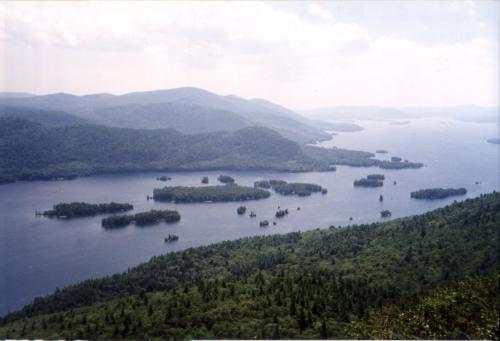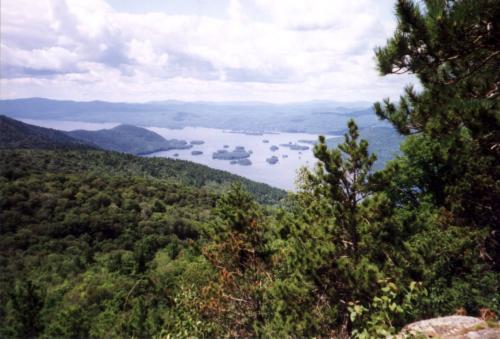The Adirondack Mountains were originally claimed by two Indian
nations, the Iroquois and the Algonquins. Neither of these two nations ever
settled in the region, but they did however fight over the LakeGeorge -
Lake Champlain water route through the Adirondacks. This was a very
valuable resource, because it was the easiest route through the Adirondacks
The Lake George - Lake Champlain water route has been the object of many
battles. In 1609, Samuel de Champlain, a frenchman, who was traveling
through the Lake Champlain area with some Algonquin Indians, when they
encountered a band of Iroquois. The French fired on the Iroquois. This was
the beginning of a feud that lasted until 1763 when the French were driven
from the area.


Lake George Narrows from 5th Mountain

The English and the French Battled over the Lake George - Lake Champlain
water route for many years. Each side saw that by controlling the land in
between the lakes they could therefore control the water route. In 1690 the
British established a trading post on Crowne Point, but soon abandoned it.
The French then seized the site in 1730. In 1731 the French built Fort St.
Frederic on Crowne Point, which grew into a small town and trading post.
St. Frederic was the first settlement in the Adirondack area.


Lake George Narrows from Black Mountain

1755 saw the British build a fort on the south end of Lake George, and named
Fort William Henry. The French not to be out done built a fort on the north
end of Lake George in Ticonderoga. The Fort was originally known as Fort
Carillon, but was later renamed Fort Ticonderoga by the British. In 1757,
as part of the French and Indian War, French General Montcalm, captured Fort
William Henry. That very summer the French were defeated. The English took
control of all the forts and forced the French from the lakes. When the war
ended and the dust settled in 1763, the English ruled all of Eastern North
America.
In May of 1775, in the wake of the American Revolution, Ethan Allen and the
"Green Mountain Boys" came across Lake Champlain from Vermont, and demanded
the surrender of Fort Ticonderoga. The first American Navy fought on Lake
Champlain against an English army invading from Canada. On October 11 1776
Benedict Arnold led a fleet of ships on Lake Champlain against the English.
His ship went down after 7 hours of battle, but they delayed the English
long enough to stop the invasion. In the next year the Americans lost
control of the lakes to the English. The English were able to advance south
to Saratoga where they were defeated and driven out of the Adirondacks. The
Adirondacks once again fell quiet.